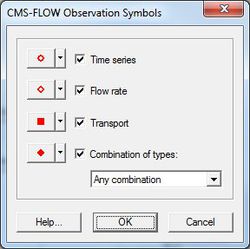SMS:CMS-Flow Observation Cells
| This contains information about features no longer in use for the current release of SMS. The content may not apply to current versions. |
CMS-Flow includes observation cells which can be used to output calculations at specific locations. Within SMS, there are two steps to output observation data. First select locations (cells) and specify the cell types as observation stations in the Cell Attributes window. Second, specify what type of data CMS-Flow will output and at what frequency, on the Cells tab of Model Control.
Model Control
Within the CMS-Flow Model Control window, the type and frequency of observation output to be written can be specified on the Cells tab. For each type (time series, flow rate, and transport), individual calculations can be selected and the Output interval will be enable if at least one calculation type is selected. Water surface (ETA) is calculated at the center of the cell, while all vectors (U and V, X and Y) are calculated at the center of the left face (for horizontal) and the center of the bottom face (for vertical) of the cell.
Display Options
CMS-Flow includes observation symbols to differentiate specifications. On the Cartesian Grid page of the Display Options window (when CMS-Flow is the active model), the Observation symbols check box controls the display of symbols that will appear in observation cells. If this is turned on, then the user must be aware of the individual symbol settings accessed by clicking on the Options... button. The Options... button displays the CMS-Flow Observation Symbols window.
Observation symbols can be selected for the three observation output types (Time series, Flow rate, Transport) and a combination of types. The specific output type symbols are displayed in an observation cell that only includes this type or, depending on the state and choice of Combination of types option, also includes this type. Since observation cells can include multiple output types, it is possible to display overlapping symbols. The Combination of types combo box specifies the qualification for the combination symbol to be displayed in an observation cell. If the combination symbol is displayed in a cell, then no other observation symbol will also be displayed in that cell. The Combination of types can be used to quickly highlight specific observation stations as follows:
- Any combination – Any observation cell that includes at least any two output types.
- Time series and flow rate – All cells that only include both time series and flow rate output types.
- Time series and transport – All cells that only include both time series and transport output types.
- Flow rate and transport – All cells that only include both flow rate and transport output types.
- All types – All cells that include all three output types.
Observation cells of only one type, such as only time series, can be found by turning on the specific type (Time series), turning off the other two types (Flow rate and Transport), and turning on and setting Combination of types to All types. The time series only observation cells will be highlighted with time series symbol (ignore the combination symbols).
If the Observation symbols check box is turned off, no symbols will be displayed and the individual settings cannot be accessed, however, the individual settings will not be changed.
Model Check
The CMS-Flow Model Checker, accessed from the CMS-Flow | Model Check... menu item, includes a check to ensure that CMS-Flow has been set up to output the specific data for any existing observation station and that observation stations exist for any specified output data. Observation is not required to run CMS-Flow so this is a reminder that something may have been intended but forgotten. It is suggested that the model checker be used prior to running CMS-Flow.
Related Topics
| [hide] SMS – Surface-water Modeling System | ||
|---|---|---|
| Modules: | 1D Grid • Cartesian Grid • Curvilinear Grid • GIS • Map • Mesh • Particle • Quadtree • Raster • Scatter • UGrid |  |
| General Models: | 3D Structure • FVCOM • Generic • PTM | |
| Coastal Models: | ADCIRC • BOUSS-2D • CGWAVE • CMS-Flow • CMS-Wave • GenCade • STWAVE • WAM | |
| Riverine/Estuarine Models: | AdH • HEC-RAS • HYDRO AS-2D • RMA2 • RMA4 • SRH-2D • TUFLOW • TUFLOW FV | |
| Aquaveo • SMS Tutorials • SMS Workflows | ||
